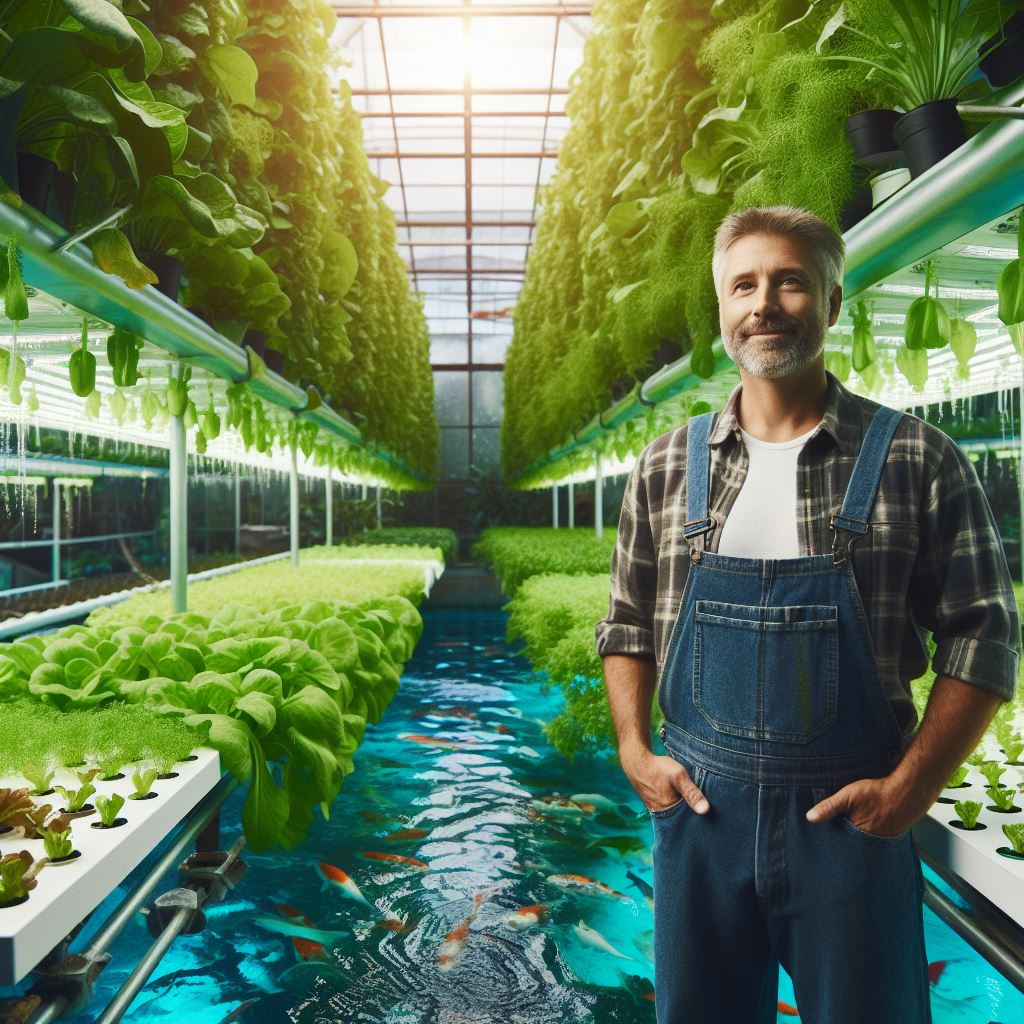Introduction
Brief explanation of what micro farming is
Micro farming refers to the practice of growing crops and raising animals on a small scale, utilizing limited space.
With the ever-increasing global population and dwindling agricultural land, maximizing space in farming has become crucial.
In today’s world, where land availability is becoming a challenge, micro farming offers a viable solution.
It involves using innovative techniques and strategies to cultivate more with less space.
By adopting this approach, farmers can effectively utilize every square foot of land they have.
Importance of maximizing space in farming
The importance of maximizing space in farming cannot be overstated.
As urbanization continues to encroach upon agricultural land, farmers must find ways to produce more food using less space.
Micro farming enables farmers to grow crops intensively, making the most of limited areas.
The benefits of micro farming go beyond just maximizing space.
It also allows for increased crop diversity, reduced water usage, and enhanced pest control.
It promotes sustainable farming practices and reduces dependence on synthetic fertilizers and pesticides.
Micro farming is not limited to traditional farming methods alone. It includes vertical farming, hydroponics, aquaponics, and rooftop gardening.
These innovative techniques utilize vertical spaces, unused buildings, and even rooftops to create productive agricultural ecosystems.
Micro farming is a practical approach to tackle the challenges posed by limited space for agriculture.
By adopting this method, farmers can efficiently utilize small areas, produce a diverse range of crops, and contribute to sustainable farming practices.
Transform Your Agribusiness
Unlock your farm's potential with expert advice tailored to your needs. Get actionable steps that drive real results.
Get StartedBenefits of Micro Farming
Ability to grow more variety of crops in a smaller space
Micro farming allows farmers to maximize their land use by utilizing vertical and hydroponic farming techniques.
This means that they can grow a diverse range of crops in a limited area.
Saving money on land and equipment costs
Traditional farming requires large expanses of land, which can be expensive to purchase or lease.
Micro farming provides an alternative with its focus on small-scale operations that can be set up in urban areas or small plots of land.
The equipment needed for micro farming is relatively affordable compared to traditional farming machinery.
Increased efficiency and productivity
The compact nature of micro farms enables farmers to optimize their resources and apply efficient farming methods.
With carefully designed systems, farmers can control factors such as lighting, temperature, and water supply to create an ideal environment for plants to thrive.
This leads to improved productivity and higher crop yields.
Reduced environmental impact
Micro farming promotes sustainable agricultural practices.
By growing crops vertically or in small plots, farmers reduce the need for chemical fertilizers and pesticides.
They also consume less water compared to large-scale farming, making micro farming an eco-friendly choice.
Additionally, micro farming reduces the carbon footprint associated with transportation since produce is grown closer to the consumer.
In addition to these primary benefits, micro farming offers several other advantages:
Accessibility
Micro farming provides opportunities for individuals with limited access to land or resources to engage in agricultural activities.
It levels the playing field by allowing people in urban areas or those with smaller plots of land to grow their own food or start small-scale farming businesses.
Community engagement
Micro farms can be established in urban areas, creating a sense of community and promoting local food production.
Urban dwellers can actively participate in the growing of fresh produce and have a better understanding of where their food comes from.
Education and skill development
Micro farming allows for hands-on learning experiences.
Schools and community organizations can incorporate micro farming into their curriculum or activities, teaching children and adults alike about sustainable farming practices, nutrition, and the importance of local food systems.
Food security
With its ability to grow a variety of crops in a limited space, micro farming can contribute to alleviating food scarcity.
This is particularly relevant in areas where access to fresh and nutritious food is limited.
Micro farms can provide communities with a sustainable source of food, reducing reliance on imported produce.
Economic opportunities
Micro farming can be a source of income generation, especially for small-scale farmers.
By focusing on high-value crops or niche markets, farmers can generate higher revenue from their small plots of land.
Showcase Your Farming Business
Publish your professional farming services profile on our blog for a one-time fee of $200 and reach a dedicated audience of farmers and agribusiness owners.
Publish Your ProfileThe direct connection between farmer and consumer in micro farming can lead to fairer prices for both parties.
Most importantly, micro farming offers a range of benefits, including the ability to grow a variety of crops in a limited space, cost savings on land and equipment, increased efficiency and productivity, and reduced environmental impact.
It also brings additional advantages of accessibility, community engagement, education, food security, and economic opportunities.
Embracing micro farming can lead us towards a more sustainable, inclusive, and resilient agricultural system.
Read: Easy Herbs for Window Gardening Success
Getting started with micro farming
Growing your own food can be a rewarding and sustainable way to live.
One method that has gained popularity in recent years is micro farming.
This practice allows you to grow more in less space, making it perfect for urban dwellers or those with limited yard space.
In this section, we will explore the key steps to getting started with micro farming.
Assessing available space and resources
The first step in micro farming is assessing the available space and resources you have.
Look at your yard or balcony and determine how much space you can allocate for growing crops.
Consider factors such as sunlight exposure, access to water, and potential limitations like nearby buildings or trees that may cast shadows.
Choosing the right crops for micro farming
Once you have assessed your space, the next step is choosing the right crops for micro farming.
Look for plants that are well-suited to small spaces and have a high yield.
Examples include leafy greens like lettuce and spinach, herbs such as basil and cilantro, and compact vegetables like cherry tomatoes and radishes.
Consider your personal preferences and nutritional needs when selecting crops.
Understanding the principles of vertical gardening and raised beds
Understanding the principles of vertical gardening and raised beds is crucial for successful micro farming.
Vertical gardening involves growing plants upwards instead of outwards, utilizing trellises, hanging baskets, or stacked containers.
Raised beds, on the other hand, are elevated planting areas that provide better drainage and soil quality.
Both methods maximize space and allow you to grow more plants in a smaller area.
Utilizing container gardening techniques
Another technique to utilize in micro farming is container gardening.
This method involves growing plants in pots or other containers instead of directly in the ground.
Container gardening is ideal for those with limited space and allows for easy mobility, making it possible to move plants indoors during colder months or rearrange them for optimal sunlight exposure.
Once you have gathered your resources and chosen your crops, it’s time to start planting.
Begin by preparing the soil or potting mix, ensuring it is loose, fertile, and well-draining.
Follow the instructions specific to each crop regarding planting depth and spacing.
Water your plants regularly and provide adequate sunlight or artificial light if needed.
In addition to watering, regular maintenance is essential for micro farming success.
Monitor your plants for signs of pests or diseases and take appropriate measures to prevent or treat them.
Remove weeds that compete with your crops for nutrients and ensure your plants have proper support if using vertical gardening techniques.
Harvesting your crops is the most rewarding part of micro farming.
As plants grow and mature, they will produce edible fruits, leaves, or roots.
Harvesting at the right time ensures the best flavor and nutritional value.
Harvest leafy greens by picking outer leaves while leaving the central ones intact for continued growth.
For fruits and vegetables, follow specific guidelines for each crop.
Micro farming is a versatile and sustainable way to grow your own food, even in limited space.
By assessing available resources, choosing the right crops, and utilizing techniques like vertical gardening and container gardening, you can maximize your harvest.
With a little planning and maintenance, you can enjoy fresh and nutritious produce right from your own micro farm.
Read: Grow Herbs on Your Porch: Simple Techniques

Tips for Successful Micro Farming
In recent years, micro farming has gained popularity as a way to grow more in limited spaces.
Showcase Your Farming Business
Publish your professional farming services profile on our blog for a one-time fee of $200 and reach a dedicated audience of farmers and agribusiness owners.
Publish Your ProfileWith proper planning and techniques, even a small area can yield bountiful harvests.
Here are some tips to ensure success in micro farming:
Proper soil preparation and composting
Begin by testing the soil’s pH level and nutrient content, and make necessary adjustments.
Improve soil fertility and structure by adding organic matter, such as compost or well-rotted manure.
Regularly turn and aerate the soil to ensure it remains loose and well-draining.
Implementing efficient irrigation systems
Install drip irrigation or use soaker hoses to provide water directly to the base of plants.
Use rain barrels to collect and store rainwater, reducing reliance on municipal water sources.
Monitor soil moisture levels regularly and water plants only when necessary to avoid water wastage.
Managing pest and disease control in small spaces
Practice crop rotation to prevent the buildup of pests and diseases in the soil.
Use natural pest control methods, such as introducing beneficial insects or companion planting.
Regularly inspect plants for signs of pests or diseases, and take immediate action to prevent their spread.
Utilizing crop rotation and companion planting techniques
Rotate crops annually to prevent pest infestations and maintain soil health.
Companion planting involves growing compatible plants together to maximize space and deter pests.
For example, planting marigolds near tomatoes can repel nematodes and other harmful insects.
Micro farming requires careful planning and attention to detail, but the rewards are well worth the effort.
By following these tips, you can optimize your small space for maximum productivity.
In addition to the above tips, here are a few more strategies that can further enhance the success of your micro farming venture:
Utilize vertical gardening techniques
Grow vining crops, such as cucumbers or beans, on trellises or vertical supports to save space.
Hang baskets or install wall-mounted planters for herbs and small vegetables, maximizing vertical space.
Implement intensive planting methods
Practice square-foot gardening, where plants are grown in small, densely planted squares.
Utilize raised beds or container gardening to optimize space usage and allow for better soil management.
Regularly monitor and maintain plant health
Check plants for nutrient deficiencies and provide appropriate fertilizers or amendments.
Prune plants regularly to promote healthy growth and improve air circulation.
Harvest in a timely manner
Harvest crops as soon as they reach maturity to maintain their quality and encourage continuous production.
Regularly remove any overripe or diseased fruits to prevent potential pest or disease outbreaks.
In essence, successful micro farming requires a combination of proper soil preparation, efficient irrigation, pest and disease control, and smart planting techniques.
By implementing these tips and strategies, you can maximize your yields and grow an abundance of fresh produce in even the smallest of spaces.
Happy micro farming!
Read: Urban Veggie Gardens: Small Spaces, Big Yields
Challenges of micro farming
Limited space and potential yield limitations
Limited space and potential yield limitations are among the primary challenges faced by micro farmers.
Unlike conventional agriculture, where vast fields allow for large-scale cultivation, micro farming is done in small areas.
This limitation in space puts constraints on the number of plants that can be grown and, subsequently, the overall yield.
Adequate sunlight and shading considerations
Another challenge encountered in micro farming is ensuring adequate sunlight and managing shading considerations.
Plants require sunlight for photosynthesis, which is crucial for their growth and productivity.
Due to the limited space, crops may cast shading on one another, restricting the access to sunlight.
This can result in stunted growth or lower yields for some plants.
Potential overcrowding and competition between crops
The relatively small areas used for micro farming can lead to potential overcrowding and intense competition between crops.
With multiple plants growing closely together, they end up competing for water, nutrients, and sunlight.
This competition can negatively affect the growth and yield of the crops, making it essential for micro farmers to carefully plan the spacing and arrangement of their plants.
Maintaining soil fertility in small areas
Maintaining soil fertility is another significant challenge in micro farming.
Showcase Your Farming Business
Publish your professional farming services profile on our blog for a one-time fee of $200 and reach a dedicated audience of farmers and agribusiness owners.
Publish Your ProfileAs the cultivation areas are small, continuous planting and harvesting can deplete the soil of essential nutrients.
Without proper soil management practices such as crop rotation, soil amendments, and organic matter incorporation, the fertility of the soil can decline.
This can hinder the growth and productivity of crops over time.
To overcome these challenges, micro farmers can employ various strategies.
Firstly, optimizing the space available through vertical farming techniques like trellising and utilizing raised beds can help maximize the number of plants that can be grown.
Using reflective surfaces to redirect sunlight towards shaded plants can address shading issues and ensure adequate light penetration.
Practicing proper crop spacing and choosing plant varieties that are compatible with each other can help minimize competition between crops.
Implementing sustainable soil management practices, such as composting, cover cropping, and utilizing organic fertilizers, can maintain soil fertility in small areas.
Employing hydroponic or aquaponic systems can further optimize plant growth in limited spaces.
In fact, micro farming presents various challenges due to limited space.
These challenges include yield limitations, sunlight and shading considerations, competition between crops, and soil fertility management.
With proper planning, innovative techniques, and sustainable practices, these challenges can be overcome, allowing micro farmers to grow more in less space.
Read: Kitchen Garden: Hydroponics for Beginners
Best practices for maximizing space in micro farming
When it comes to micro farming, space is often a limiting factor. However, with the right techniques and strategies, you can grow more in less space.
Here are some best practices for maximizing space in micro farming:
Utilizing vertical gardening structures
One of the most effective ways to maximize space in micro farming is by utilizing vertical gardening structures.
This includes using trellises and vertical planters to grow plants upwards instead of outwards.
By doing so, you can make use of the vertical space available, allowing you to grow more plants in a smaller area.
Intercropping and succession planting techniques
Intercropping is the practice of growing different crops in the same area at the same time.
Succession planting, on the other hand, involves planting new crops as soon as one crop is harvested.
Both techniques can help maximize space by ensuring that you have a continuous supply of fresh produce throughout the growing season.
By intercropping and practicing succession planting, you can make the most out of every square inch of your micro farm.
Utilizing space-saving planting methods
Square foot gardening is a space-saving planting method that allows you to grow a variety of vegetables and herbs in a small area.
The concept is simple – divide your growing space into square foot squares and plant a different crop in each square.
This technique maximizes space by eliminating wasted areas and allows for better organization and planning of your crops.
Incorporating hydroponics or aquaponics systems
Hydroponics and aquaponics are soil-less cultivation methods that can be highly space-efficient.
Hydroponics involves growing plants in nutrient-rich water, while aquaponics combines hydroponics with fish farming. Both systems can be set up vertically and require minimal space.
By incorporating hydroponics or aquaponics into your micro farming setup, you can maximize your growing area and produce a higher yield.
In short, maximizing space in micro farming is essential for increasing productivity and yield.
By utilizing vertical gardening structures, intercropping and succession planting techniques, space-saving planting methods, and incorporating hydroponics or aquaponics systems, you can grow more in less space.
With these best practices, micro farming becomes a viable and sustainable solution for producing fresh and healthy food, even in limited areas.
Conclusion
Micro farming offers numerous benefits such as increased food production, sustainability, and cost-effectiveness in small spaces.
It also poses challenges such as limited space, specialized knowledge, and potential yield constraints.
Despite these challenges, it is worth considering micro farming as a viable option for maximizing yield in limited spaces.
By using innovative techniques such as vertical gardening, hydroponics, and aquaponics, individuals can cultivate a variety of crops in small areas.
If you are interested in exploring micro farming further, there are many additional resources and references available.
Websites, blogs, and forums dedicated to micro farming provide valuable information, tips, and success stories from experienced micro farmers.
Furthermore, attending workshops, webinars, and local farming events can offer hands-on learning opportunities and connect you with a supportive community of micro farmers.
Micro farming is a practical way to grow more in less space.
So why not give it a try?
Showcase Your Farming Business
Publish your professional farming services profile on our blog for a one-time fee of $200 and reach a dedicated audience of farmers and agribusiness owners.
Publish Your ProfileStart small, educate yourself, and enjoy the rewards of growing your own food sustainably.




